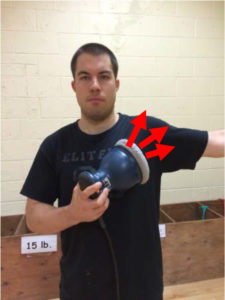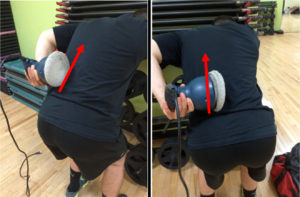Whether you are a serious athlete seeking improved sports performance or a casual weekend warrior crushing cathartic heavy deadlifts, most veteran gym goers understand that the iron game is a long term investment. The key to success is accumulating hours of consistent quality stimulation over a long period of time.
A serious impediment to obtaining this aforementioned goal is suboptimal tissue quality and impaired movement. In recent years, self myofascial release and foam rolling have swept the strength training community as a means to ameliorate these deficits. Although the science regarding foam rolling remains a contentious issue, many practitioners and athletes consider the practice a staple of proper recovery. Although this article will not discuss the background and science of foam rolling, as the Brink Zone includes innumerable resources concerning the topic, it will instead introduce a new potent tool for your extensive recovery arsenal.
Time to get Buff
One day during a training session, a good friend of mine revealed a car buffer from his training bag. Although I started laughing, as it was typical for this avid engineer to regularly carry spare tools. What did surprise me however, was when he instructed me to apply the device to my adductors. At first I was skeptical, but with some enticing I positioned my foot upon a bench and began to buff the inner portions of my leg. Fighting the urge to pull away, I was instantly stunned by the precise intensity of the pressure. Despite its common use as a car polisher, the newly repurposed tool now functioned as a Brookstone massage wand on steroids. After a few concentrated strokes across the length of my adductors, I instantly experienced relief. My friend began to smile as he realized my astonished delight and subsequent excitement. Soon I was buffing my pecs, traps, quads, calves, and any other area that I could reach. It appeared that this tool provided an enhanced self myofascial release in a fraction of the time. Before I could recommend the tool to my fellow friends and clients I decided to experiment for a month. The results were absolutely tremendous and I expressed to my friend the possibility of marketing a new product. Together we began to research and soon discovered that similar to many other fitness “discoveries,” we were not truly original in our self massage epiphanies.
It appears that Clint Darden and Brett Summers had discovered the massage technique years ago but were largely unnoticed. Their original article can be read here. In relation to introductory self myofascial release techniques, this guide can be viewed in conjunction with Mike Robertson’s PDF here for added completeness.
So, instead of plagiarizing these articles, claiming the discovery for ourselves, as seems to be the standard in the fitness industry, I have decided to detail my experiences with the buffer and my opinion of related applications.
IMPORTANT NOTE:
I must first mention that although self myofascial release is a potent tool for restoration I also consider its application more so as the weightlifter’s canary. What I mean by this phrase is that if an area is exhibiting consistently poor tissue quality, this information usually indicates inappropriate programming, suboptimal movement, and compromised structural balance. If you find these patterns to be reoccurring, it would most likely be best to communicate with a coach to troubleshoot minor problems before they become major. That being said, listed below is my analysis of areas that I have applied the buffer.
Upper Extremities
 Pectoralis Major and Minor: The buffer is an excellent tool for this area. Unlike the presented video I find self application relatively easy and effective. Simply raise your arm, tilt the buffer at an angle and apply pressure in two patterns. One pattern is to target a particular adhesion and apply pressure. The other pattern is to work from the inner pectoralis (pec) muscles on outward in a fan fashion that best resembles the fan fibers of the muscles. The first is usually reserved for points of convergence at the pec minor while the latter technique is usually most effective when employing broader strokes across the pec major.
Pectoralis Major and Minor: The buffer is an excellent tool for this area. Unlike the presented video I find self application relatively easy and effective. Simply raise your arm, tilt the buffer at an angle and apply pressure in two patterns. One pattern is to target a particular adhesion and apply pressure. The other pattern is to work from the inner pectoralis (pec) muscles on outward in a fan fashion that best resembles the fan fibers of the muscles. The first is usually reserved for points of convergence at the pec minor while the latter technique is usually most effective when employing broader strokes across the pec major.
Lattissimus Dorsi: Buffering this area is moderately effective. I typically find longer deep strokes with a foam roller to be more effective in this regard but the buffer can supplement this technique for added completeness.
Triceps: I do not consider the buffer to be particularly effective in this specific area and instead recommend using firm long strokes across a smith machine barbell or mounted barbell within a power rack. Incorporating front squat grips into squatting or lunging can also help release the musculature.
Starting position for Lat technique
Protip: plug in buffer for maximal results
 Posterior Shoulder Capsule– The buffer can be effective in this area but pressure must be applied with caution. I typically utilize a lacrosse ball for added precision but similar to other areas, the buffer can be added for completeness. The position for this technique is similar to the lat and teres pictures.
Posterior Shoulder Capsule– The buffer can be effective in this area but pressure must be applied with caution. I typically utilize a lacrosse ball for added precision but similar to other areas, the buffer can be added for completeness. The position for this technique is similar to the lat and teres pictures.
Infraspinatus and Teres Minor– Very similar to the posterior shoulder capsule I typically utilize a lacrosse ball for added precision but buffing can be added for overall completeness.
Thoracic Musculature- As is the case with foam rolling, avoid applying pressure directly to the spine. Although this particular region is best addressed with broad strokes of the foam roller, I have experienced benefits when utilizing a partner for buffer assistance. To utilize the partnered technique, lay on the ground, stomach down , and instruct your partner to apply pressure to the thoracic musculature. Just remember to practice safe buffing and employ a safety word if needed. If you have access to a glute ham raise machine or can fashion an analogous setup mentioned in the original article, I imagine you could properly address this region in a similar fashion . Self massage is still possible as shown below.
 Rhomboids/Scapula- This is an excellent area for buffering but might require a partner depending on your flexibility and mobility. Typically I can reach this area if I assume a quadraped position and reach with the buffer behind my back. If I am seeking a more comprehensive approach, a similar technique to the one mentioned for the thoracic musculature can be utilized. If you have access to a glute ham raise or can fashion a similar setup mentioned in the original article, I imagine you could properly
Rhomboids/Scapula- This is an excellent area for buffering but might require a partner depending on your flexibility and mobility. Typically I can reach this area if I assume a quadraped position and reach with the buffer behind my back. If I am seeking a more comprehensive approach, a similar technique to the one mentioned for the thoracic musculature can be utilized. If you have access to a glute ham raise or can fashion a similar setup mentioned in the original article, I imagine you could properly address this region. Depending on time spent dedicated to Westside Powerlifting, attempting to buffer this region by yourself might result in a post workout Ibuprofen cocktail and someone speed dialing 911 and. As always, exercise caution when experimenting with possibly compromising positions.
address this region. Depending on time spent dedicated to Westside Powerlifting, attempting to buffer this region by yourself might result in a post workout Ibuprofen cocktail and someone speed dialing 911 and. As always, exercise caution when experimenting with possibly compromising positions.
Upper/Middle and Lower Trapezius: This area is ideal for buffering and my main area of concentration when approached from multiple angles. For added completeness a partner can be utilized or you can utilize the glute ham raise setup when appropriate. Be sure to tilt the head away as you massage for maximal benefit.
Wrist Extensors/ Flexors – This area is not recommended for buffering and is best addressed with other tools such as barbells, self myofascial release rolling sticks, or with your own hands and a bottle of massage cream. Be sure to first set the mood with a glass of sparkling Rose and your favorite Michael Buble playlist.
Lower Extremities
NOTE: If you want to see the pictures for lower extremities, click Buff to get Buffer for PDF
Gastrocnemius/Soleus: The calves are an area where the buffer truly shines. In the past I have always experienced difficulties and significant pain when attempting to release these areas using conventional methods. This was immediately resolved after my first buffering experience. If you have calf tissue issues the buffer might be your savior.
Plantar Fascia: This area is not appropriate for buffering and should instead be addressed with a lacrosse ball or similar implement.
Peroneals/Tibialis Anterior: Buffering is moderately effective in this region. Unfortunately as mentioned in the beginning, if your Tibialis Anterior is constantly exhibiting compromised tissue quality, self myofascial might be a band aid for inappropriate programming, movement, and related structural balance. I would therefore stress primarily addressing the latter as opposed to understanding new methods of self myofascial release in this particular compartment.
Tensor Fascia Latae, Anterior Gluteus Medius, Gluteus Minimus: Buffering should serve as the initial wave of release to address the broader areas. After sufficient buffering has addressed the majority of tissue in the region, I would strongly suggest a second sweep with a lacrosse ball in the more concentrated areas to obtain a more precise release.
IT Band: I would not recommend buffering this area as foam rolling this segment is a controversial topic. If you are comfortable with rolling this area, I would strongly recommend utilizing the broad strokes of a foam roller and attempting to fully understand why this area may be exhibiting consistent compromised tone.
Vastus Lateralis: This is an ideal area for buffering as the groove and broad nature of the fibers seems to be very receptive to the type of pressure offered by the buffer. This is one of my favorite areas to apply the buffer.
Rectus Femoris: A combination of broad roller strokes and concentrated buffering either in vertical columns or segmented rows seems to be ideal.
Vastus Medialis: This is another area that seems to be well suited for buffering. I would recommend broad buffer strokes to start and finishing with a lacrosse ball if further precise release is desired.
Quadriceps: As mentioned before, this large muscle group seems to be very receptive to buffering and should be a primary target for broad buffering strokes.
Glueteus Maximus and Medius: Although some of my friends swear that a concentrated blast of buffering in a cross legged position can properly address tone, I much prefer utilizing a lacrosse ball even if this option usually results in gritted teeth, yelps and contorted faces with every pass.
Piriformis: Similar to the Gluteus complex, I would not consider the priformis an ideal buffering location but would instead strongly recommend the precise concentrated pinning approach of a lacrosse ball.
Adductors: This area is ideal for buffering and is one of the main reasons why I strongly recommend the tool to any serious weightlifter. In the past I would typically spend inordinate amount of time pseudohumping various medicine balls or barbells attempting to release nasty adductor trigger points. Fortunately, the buffer obtains the same results in less time, less pain, with more precision, and in a somewhat less awkward manner. You will still garner weird looks from unaware gym goers, but at least you will not be identified as the creepy dude with the foam roller fetish. If you are a male, be sure to cup your prized jewels unless you intend to exchange your pair for a Darwin Award.
Hamstrings: Similar to the adductors, this area seems to be very receptive to buffering. If the region is especially troublesome, I would suggest following buffering with time spent rolling against a barbell and once again reanalyzing the inappropriate programming, movement, and related structural balance that might be eliciting this response.
Conclusion: Similar to most tools in the gym, the buffer is a tool and should be treated as such. It will compliment your original techniques and add another dimension to your recovery strategies. Since the car buffer only costs between $20-30, I consider this purchase a no brainer especially when factoring the saved time and money that can now be redistributed to your ever-growing coffee fund.
Never leave home without it!

Matt is a licensed registered dietitian nutritionist and certified strength and conditioning specialist. He is the dietitian and exercise science advisor for the Walden GOALS program and the Sports Nutrition and Exercise Science Specialist for Walden Behavioral Care. Before working at Walden, Matt devoted the early part of his career to refining the art and science of training elite collegiate and professional athletes. In graduate school, he developed expertise in nutrition, behavior change and eating disorders. Matt now devotes his practice to translating nutrition and exercise science into practical solutions. As Walden’s Sports Nutrition and Exercise Science Specialist, Matt is known for his dedication to educating and empowering patients of all backgrounds to facilitate a full and meaningful recovery from disordered eating and problematic physical activity. Matt holds a B.S. degree in Kinesiology from the Honors College at The University of Massachusetts Amherst, a master’s degree in Applied Exercise Physiology and Nutrition from Columbia University and was a dietetic intern at Boston’s Brigham and Women’s Hospital.







I I completely agree. I don’t know why they haven’t done so already.